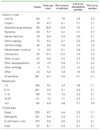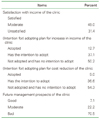A survey of the medical practitioners' offices in Korea 2011
Article information
Abstract
Because of various current problems and issues which are low health insurance medical fee of National Health Insurance Corporation, extreme competition with very large general hospitals, new supply of more than of 3,000 new doctors, many medical practitioner's offices who are suffering management difficulties are increasing. In order to investigate their current overall management situations, we made this study through statistical extraction procedures with the sample population of the medical practitioners which are registered in Korean Medical Association and subsequently we made the study with 1,031 selected cases. The average number of patients is 53.6 patients per day. 44.4% of the medical practitioners' offices are working at night and legal holidays and 8.5% are working at Sunday. Average working hours is 50.1 hours per week, which greatly exceeds 40 hours per week that is regulated in the Labor Standards Act. According to the management performance analysis of those medical clinics through profit and loss statements, average total annual sales revenue in 2010 fiscal year was 444,167,867 KRW, the expenses were 314,217,081 KRW and the earnings before taxes was 129,940,786 KRW. The average net profit (earnings before taxes) of the director of the medical practitioners' offices was 122,337,868 KRW per year and 10,194,822 KRW per month. According to the study results, we have found that we need to increase doctor's bill for outpatient, and establishment and its improvement of medical service delivery systems and classification standards of medical services for first and succeeding outpatients. Considering overall results of the study, readjustment of outpatients' treatment fees and reestablishment of more efficient medical service delivery systems which require the first medical service is to be provided properly should be realized in order to improve the management performance of the medical practitioners' offices.



















